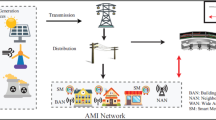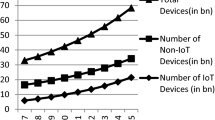Abstract
Wide Area Monitoring Systems (WAMS) improve situational awareness in the electric grid. They support planning and optimizing of grid operations and provide valuable information to prevent critical incidents. Communication demands for WAMS have been elevated by the variety of applications that rely on measurement data from distributed sensors. Besides bounds on tolerated end-to-end latencies for some applications, security is a major concern in todays Wide Area Monitoring Systems. We review recent approaches for WAMS communication and point out security challenges that need to be addressed in future communication solutions for WAMS.
Zusammenfassung
Wide Area Monitoring-Systeme (WAMS) formen Netze aus verteilten Sensoren zur Überwachung von intelligenten Stromnetzen (Smart Grids). Sie unterstützen Planung und Optimierung von Prozessen im Elektrizitätsnetz und liefern wertvolle Informationen zur Prävention von kritischen Ereignissen. Viele Anwendungen benötigen aktuelle Messdaten, um auf neue Situationen in intelligenten Stromnetzen reagieren zu können. Damit steigen auch die Kommunikationsanforderungen für Wide Area Monitoring-Systeme. Neben Anforderungen bezüglich der maximal tolerierbaren Ende-zu-Ende-Verzögerungszeiten sind heutzutage vor allem Sicherheitsmechanismen von hoher Bedeutung für Wide Area Monitoring-Systeme. Wir vergleichen verschiedene Ansätze für WAMS-Kommunikation und zeigen, welche Sicherheitsanforderungen in zukünftigen Kommunikationslösungen für WAMS berücksichtigt werden müssen.

Similar content being viewed by others
References
IEC (2012): IEC TR 61850-90-5: Communication networks and systems for power utility automation—Part 90-5: Use of IEC 61850 to transmit synchrophasor information according to IEEE C37.118, May 2012.
Zseby, T. (2012): Is IPv6 ready for the Smart Grid? In CyberSecurity 2012, international conference on cyber security, Washington D.C., USA (pp. 157–164).
Farinacci, D., Lin, S., Luby, M., Edmonstone, R., Gemmell, J., Rizzo, L. (2001): RFC3208: PGM reliable transport protocol specification, Dec-2001.
Stewart, R. (2007): RFC4960: stream control transmission protocol, Sep-2007.
Floyd, S., Handley, M., Kohler, E. (2006): RFC4340: datagram congestion control protocol (DCCP), Mar-2006.
IEEE Standard for Synchrophasor Measurements for Power Systems (2011): IEEE Std C371181-2011 Revis. IEEE Std C37118-2005 (pp. 1–61).
IEC (2002–2005): IEC 61850 communication networks and system in substation automation.
Martin, K. E. (2011): Synchrophasor standards development—IEEE C37.118 & IEC 61850. In 2011 44th Hawaii international conference on system sciences (HICSS) (pp. 1–8).
Hardjono, T., Weis, B., Rowles, S. (2011): RFC6407: the group domain of interpretation, Oct-2011.
IEC (2007): IEC/TS 62351-6: power system management and associated information exchange—data and communications security—Part 6: Security for IEC 61850 profiles.
Cisco Whitepaper: PMU networiking with IP multicast (2012)
Jacobson, V., Frederick, R., Casner, S., Schulzrinne, H. (2003): RFC3550: RTP: a transport protocol for real-time applications, Jul-2003.
Budka, K. C., Deshpande, J. G., Thottan, M. (2014): Smart Grid data management. In Communication networks for Smart Grids (pp. 265–284). London: Springer.
German Federal Office for Information Security (2013): Office protection profile for the gateway of a smart metering system—v1. 2, 18-Mar-2013.
Rescorla, E., Modadugu, N. (2012): RFC6347: datagram transport layer security version 1.2. IETF, Jan-2012.
Alshamsi, A., Saito, T. (2005): A technical comparison of IPSec and SSL. In 19th international conference on advanced information networking and applications, 2005. AINA 2005 (Vol. 2, pp. 395–398).
IEEE standard communication delivery time performance requirements for electric power substation automation (2005): IEEE Std 1646-2004 (pp. 0_1–24).
Weerathunga, P. E., Samarabandu, J., Sidhu, T. (2012): Implementation of IPSec in substation gateways, presented at the 2012 IEEE 6th International Conference on Information and Automation for Sustainability (ICIAfS) (pp. 327–331).
Kotuliak, I., Rybar, P., Truchly, P. (2011): Performance comparison of IPsec and TLS based VPN technologies, presented at the 2011 9th International Conference on Emerging eLearning Technologies and Applications (ICETA) (pp. 217–221).
Hardjono, T., Weis, B. (2004): RFC3740: the multicast group security architecture, Mar-2004.
Hardjono, T., Weis, B., Baugher, M. (2003): RFC3547 (obsoleted): the group domain of interpretation, Jul-2003.
Dondeti, L. R., Lindholm, F., Baugher, M. (2005): RFC4046: Multicast Security (MSEC) group key management architecture, Apr-2005.
Maughan, D., Schneider, M. (1998): RFC2408 (obsoleted): Internet Security Association and Key Management Protocol (ISAKMP), Nov-1998.
Eronen, P., Kaufman, C., Nir, Y., Hoffman, P. (2010): RFC5996: Internet Key Exchange protocol version 2 (IKEv2), Sep-2010.
Law, Y. W., Gong, Z., Luo, T., Marusic, S., Palaniswami, M. (2013): Comparative study of multicast authentication schemes with application to wide-area measurement system. In Proceedings of the 8th ACM SIGSAC symposium on information, computer and communications security, New York, NY, USA (pp. 287–298).
Wang, Q., Khurana, H., Huang, Y., Nahrstedt, K. (2009): Time valid one-time signature for time-critical multicast data authentication. In IEEE INFOCOM 2009 (pp. 1233–1241).
Law, Y. W., Palaniswami, M., Kounga, G., Lo, A. (2013): WAKE: key management scheme for wide-area measurement systems in smart grid. IEEE Commun. Mag., 51(1), 34–41.
Mizrahi, T. (2011): Time synchronization security using IPsec and MACsec, presented at the 2011 International IEEE Symposium on Precision Clock Synchronization for Measurement Control and Communication (ISPCS) (pp. 38–43).
Treytl, A., Hirschler, B. (2010): Securing IEEE 1588 by IPsec tunnels—an analysis, presented at the 2010 International IEEE Symposium on Precision Clock Synchronization for Measurement Control and Communication (ISPCS) (pp. 83–90).
Fabini, J., Abmayer, M. (2013): Delay measurement methodology revisited: time-slotted randomness cancellation. IEEE Trans. Instrum. Meas., 62(10), 2839–2848.
Author information
Authors and Affiliations
Corresponding author
Rights and permissions
About this article
Cite this article
Zseby, T., Fabini, J. Security Challenges for Wide Area Monitoring in Smart Grids. Elektrotech. Inftech. 131, 105–111 (2014). https://doi.org/10.1007/s00502-014-0203-3
Received:
Accepted:
Published:
Issue Date:
DOI: https://doi.org/10.1007/s00502-014-0203-3




